Lisa Kereszi received a Bachelor of Arts degree from Bard College in 1995. After moving to New York City she worked as an assistant to Nan Goldin before returning to graduate school at Yale University’s School of Art, where she earned her M.F.A She has subsequently taught at the International Center of Photography and School of Visual Arts and has also been a visiting artist and critic at the University of North Carolina, Chapel Hill; Massachusetts College of Art; and Vassar College. She is currently on faculty at Yale as a Lecturer and Acting Director of Undergraduate Studies in Photography.
Her work has been included in exhibitions at the Whitney Museum of American Art, the Aldrich Museum, the Bronx Museum of Art, the Brooklyn Museum of Art, and the Berkeley Art Museum, among many other museums and galleries. Her photographs are also included in many private and public collections including the Whitney Museum of American Art, the Altoids Curiously Strong Collection of the New Museum of Contemporary Art, the Brooklyn Museum, the Berkeley Art Museum, and the Yale University Art Gallery. Kereszi is represented by Yancey Richardson Gallery in New York, where she has had several solo exhibitions. Another one is being planned for late 2012.
Her editorial work has appeared in books and magazines, including The New York Times Magazine, The New Yorker, Nest, New York, Harper’s, W, The London Telegraph Sunday Magazine, Details, GQ, Jane, Newsweek, House & Garden, Wallpaper* among others. She was included in the 2003 list of the 30 top emerging photographers by Photo District News, and was granted a commission to photograph Governors Island by the Public Art Fund in 2003, which culminated in shows at the Urban Center Gallery and the Mayor’s Ceremonial Office at City Hall, as well as an exhibition catalog.
Kereszi has so far published two monographs — ‘Fantasies’ (Damiani Editore, 2008) and 'Fun and Games’ (Nazraeli Press, 2009). She was working on a third as we conducted this interview.

© Lisa Kereszi Portrait
When did you first find yourself drawn to photography? Am I remembering correctly that you were also interested in writing at Bard?
Lisa Kereszi (LK): I always took pictures. I had a Kodak disc camera when I was a kid and photographed a lot, although I never thought of it as a career choice. My mom had wanted to be a writer, so I think she really pushed me in that direction, if you can even call it pushing. It was pre-helicopter-parents days. I shot beach scenes in New Jersey, made sure I documented all of my friends (at least one picture each, as if to prove I had them) and also set up my Barbies as if they were in action at the pool or at a party or something. In high school, I was in the “Art Major” program, run by the most amazing teacher, Mr. Falcone. We didn’t have photography, but we routinely painted large 4x6 foot and 4x4 foot paintings on plywood. Luckily, I had a giant ‘66 Impala, so my paintings actually fit fully inside the trunk. I wasn’t a very good draftsman, so it kind of makes sense that I would use a camera once I got my hands on a real one. At Bard, I tried to get into photography as a freshman, but because I waited too long on registration day for the poetry professor to put up his class list (I didn’t get in), I went over to [the photography] studio too late. The following year, I knew to go to photo first. I also knew to try a different poetry workshop teacher, John Ashbery, who did let me in.

© Lisa Kereszi, Junkyard office with TV, Trainer, Penna. 2001
You’ve studied with a handful of very interesting contemporary photographers at Bard and at Yale. What did you learn from them as it concerns your artistic practice and your teaching practice?
LK: At Yale, I studied mainly with Tod Papageorge, Gregory Crewdson and Philip-Lorca diCorcia, with lots of other guest critics in and out. Even Jerry Saltz, who was there for some of the crits, made an impression on me by giving me a copy of [Roland] Barthes’s Camera Lucida to read. The whole idea of the “punctum” was very important for me to learn. PL [diCorcia] told it like it was, which was often difficult to hear. Greg taught be about artistic obsession, and about how you are who you are, and you never really escape yourself. Tod taught me that a photograph is not necessarily equal to reality—at all. Once you filter the world through your head, it’s a fiction, and expression. He also taught me to let go of my writer’s block that I carried from Bard, by showing me how I could make a poetry of the visual, rather than out of words. At my sophomore review, a poetry lit teacher told me that I did not have the love of language necessary to become a poet. I was devastated, but I suppose he was right. Hanging on to the meaning of words does carry into my photography still, though, as words appear out of context over and over again in my pictures.

© Lisa Kereszi, Ferris Wheel mural, Broadway Arcade, Times Square 2004
As for my own teaching, I feel like you figure it out on your own, to a degree. I actually lean more on my time at Bard for figuring out what needs to be taught. Too bad I wasn’t paying enough attention as a student, or as a [teaching assistant] for Lois Conner and Laura Letinsky in graduate school, because there was a lot to learn about the classroom that I could have used now. I was very distracted by life and nonacademic pursuits, I guess.
Did you work for Nan Goldin between undergraduate and graduate school? What did you learn from that relationship? What were your duties?
LK: It was 1997-8, and it began as an internship, which turned into a four days a week paid gig most weeks when another assistant decided to leave. I came on just as [Goldin’s] Whitney retrospective was being planned, and I remember going to Kinko’s in midtown to make color Xerox enlargements from her duplicate slides of various sizes to use to hand make the book dummy for 'I’ll be Your Mirror’, the exhibition catalog. (Ironically, this is also how I am reworking my own book dummy right now, cutting and pasting inkjets over the printed-out PDF of the rough draft. So there’s proof right there of something practical I learned!) Also, over the year and a half or so, I did a lot of filing and organizing of papers, faxes and slides. I got to see so many of her unpublished works in slide form in the cabinets. I worked in the dusty, cat-hairy Bowery studio where she once lived and made some of the famous pictures. I also ran a lot of errands, which was great, because I got outside and got to know the city really well; it was my second job after Bard. This is before the Internet, so if Nan needed a certain book or video or CD, I had to call ahead to various shops, Kim’s Video or Tower, etc… . to see if they might have it, then physically run over there to look. There was no Amazon. It must be so much easier to work for her now.
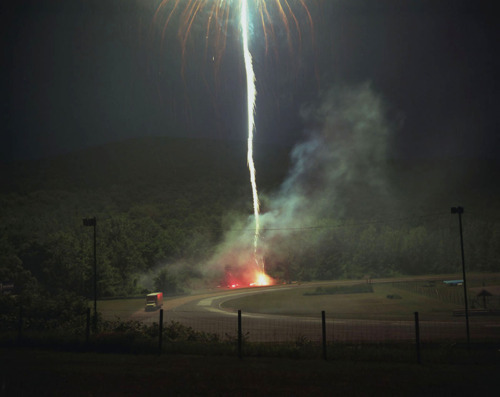
© Lisa Kereszi, Fourth of July at the racetrack, Salisbury, Conn. 1999
It was a great job, and I got to meet her friends from the photos: Sharon, who was in Pecker by John Waters, Rick, Pawel, David Armstrong, of course. I also got to meet important people in the art world at a young age, like curators Elisabeth Sussman and Corey Keller (who I am still in touch with), Matthew Marks, Walter Keller and Hans Werner Holzwarth from SCALO, John Waters, a personal hero of mine. Nan was really seductive and generous, but it was also a difficult, codependent relationship at times. I was so young and was just sucked in, but only to a point. It was really a paid one-way friendship. I mean, she was great to me, but really, I was meant to be there for her. I had thought it was going to be a two-way street, for some reason, not sure why. Maybe because I was so young and naive. I wouldn’t change it for anything, though, because I learned so much. I also know that the experience led me directly to where I am now, and for that I am grateful. If I hadn’t been working for her while she was on the weekly critique panel at Yale, I don’t know when I would have even heard about the program. She hired Dana Hoey to do a summer internship right out of Yale, and Dana would tell me stories about “crits,” and about visiting artists like O. Winston Link, who, she said, played his train recordings in a darkened room. They begin with silence, maybe a rustling, maybe a dog barking, and then the distant whistle of the train announces meekly that there is about to be a major rush of sound and power, which then slowly dissipates back into silence. She said that the class was moved to tears. I knew, right then and there, that I wanted to go there. People never really believe that I had been so naive, but it’s true. Remember that I grew up as a junkman’s daughter. Most people didn’t go to college, let alone graduate school. I thought grad school was for doctors and scientists, not artists. Also, in college, I think there was some sense that the Bard photography education was somehow “enough,” and that an MFA wasn’t necessary. It was truly a great education, but was clearly not all I needed. My work changed so much in graduate school; I learned to love the work of so many more photographers.
Can you describe the undergraduate program at Yale — is it very different from Bard’s program? What classes do you teach? Do you feel strongly about sticking to a darkroom course as the foundation of a photography education?
LK: Yale is obviously a different place than Bard, and also different than an art school, even though we exist within the School of Art. It is a big university, and we don’t have the luxury of as many offerings as an art school would. We have other luxuries, though, like the Yale Art Gallery, and the MFA program. I think we have more offerings than other universities and colleges that are not particularly strong in the arts. I wish we could have a whole semester or year to really get into the nitty-gritty of this or that technical or critical thing. We have Intro Photo, which you can take in black-and-white or in digital. Ditto with Intermediate. We have a 300-level technical seminar that is very heavy on using a view camera, taught by Benjamin Donaldson, and also an Advanced class, which is basically a project seminar.

© Max Saltarelli, Black Widow, 2011, (Lisa Kereszi student's work)
We have one section of each almost every semester, and several sections of the 100-level classes. Honestly, though, we could fill the Digital Intro course many, many times over. We had 90 students show up for 16 slots this term — a record. We just don’t have the funding from the university to have fully staffed digital facilities that can handle one to two photo classes in there every day of the week. Before I came and was asked to nominally direct the undergrad program under Papageorge’s helm, we only had Intro (black-and-white only), Intermediate, and Advanced. I told him about the Bard program (from which he would routinely accept students for Yale’s MFA program) and he agreed to try adding a few more specific courses. Part of the problem, I thought, was that students could get to Advanced without enough technical training. We were trying to address that. Also, for the undergrads who are very serious about photography, I tell them to go to the graduate critiques and to attend visiting artist talks, which are both weekly. I am always disappointed with how few of them actually can fit this in to their schedules. The best thing about being a photo student at this school is getting front-row access to all the things happening on the graduate level.
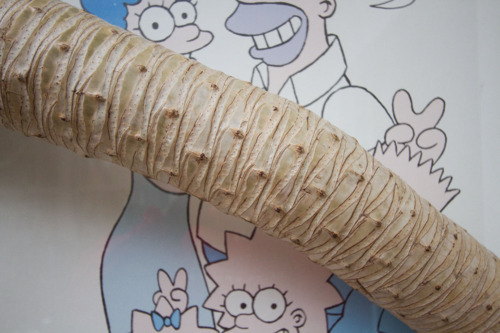
© Farah AlQasimi, Simpsons, 2011 (Lisa Kereszi student's work)
I teach some combination of Intro in black and-white or in digital; Intermediate, which introduces them to medium-format cameras and lighting; and/or Advanced. I also participate in the weekly MFA critique panel. There are also independent study students, and a handful of seniors working on their thesis projects who need to be advised. Digital is definitely a huge force, and it really has replaced our Color class, since color printing happens digitally now, rather than with the old RA-4 machine. Whereas I used to have 35-plus students come out for 16 spots in Intro, now I have between 15 and 30, and that is because 60 to 90 people are going out for each section of Intro in digital. The best students, these days, are the ones who are sure to take both, and who don’t think they can skip one or the other. Right now I have a senior who was accepted to both sections, and he actually chose black-and-white, because he recognized that this was something he probably wasn’t ever going to be able to do again—take a black-and-white class out in the world after college. It sounds impractical in the 21st century, but I really admire his willingness to be open and learn it first».

© Lauren Ritz, Jenna Asleep, 2011 (Lisa Kereszi student's work)
What would you say are your own central concerns with your own work? – Are you interested in perception, subject matter, history? Your work on Governors Island—and particularly Coney Island and the strip clubs—have strong subject matter as well as a lot of attention paid to how photography describes these already visually rich and slightly unreal facades and landscapes.
LK: Oh God, all of the above. Yes, it’s about history and what has passed on a certain stage, but it’s also about photography and perception, and transforming the world into something poetic in a way that can only be done with our medium. And the subject matter is important, too. I don’t know exactly why I am drawn to one thing or another, but I am, and I have to just follow my instincts. I guess all I can really shoot are these surfaces of things, something I learned from Stephen Shore. I have to figure out how to make that surface sing, or tell a story, or let me in, or do something magical and worthy of attention by how the light hits it, and at some certain angle, with some certain framing. All I have is the facade that I am often drawn to, so how do I make it full of meaning?
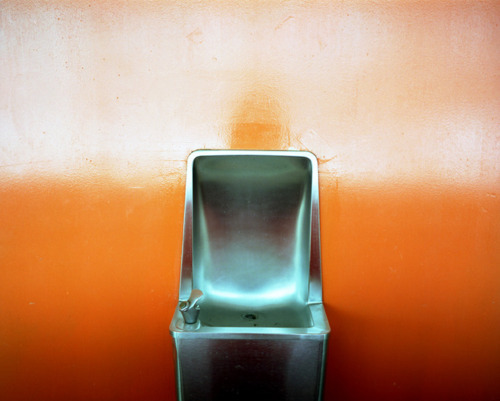
© Lisa Kereszi, Water Fountain, PS 26, Governors Island, NY 2003
Can you tell us about what you’re working on now? Your web site has a work in progress that appears to be about your physical surroundings in New Haven. What’s the genesis of that project and are you still working on it? How does your approach differ from your earlier work, given the quieter subject matter?
LK: Yes, it very much is still a work in progress. I am planning a show for late 2012 at Yancey Richardson, but the images aren’t set in stone yet. The pictures are not necessarily all about my surroundings and are made all over—Detroit, Pennsylvania, the Jersey Shore, Oregon, even Tuscany. What they have in common is a couple of themes. One is a sense of the party being over—a place that is past its prime, sort of a metaphor for the economic times we’re living in now. The other thing is that many of them are doors or windows or reflections that serve as portals into another space—for a release of sorts out in a make-believe world. The content is a bit quieter, as it is mostly outdoors, but not entirely. Some of the same kinds of places are visited, like a strip club and a movie theatre, but now I am out in the parking lot instead. There’s just more daylight, even if it is tempered by cloudy or stormy skies.
How did your work with the New Yorker come about? Can you discuss how that work is different from other areas you work in?
LK: I have been doing editorial work the whole time, really, since graduating from Yale. My first large-circulation publication was in Jane Magazine starting in 2000. Prior to that, I shot bands in small clubs for a trade mag called Gig for $50-75 a pop. I quickly moved to Details and the New York Times Sunday Magazine, and then worked for a lot of different magazines over the last decade. I had some great assignments for magazines like GQ that sent me all over the world and into people’s homes and lives, but I also had some really crappy ones that made me just want to go home and cry in the bathtub. Working for the New Yorker has been great, and I suppose it began when they discovered my work while doing research for a photo to illustrate a fiction piece, or perhaps it was from running one of my pictures to go with a listing for one of my early solo shows in the front of the magazine. That first fiction piece used a picture of Angie Pontani, a neo-burlesque queen. She said that she was on the 6 train platform that week the picture came out, and some guy was reading the New Yorker a few feet away from her. He looked up, did a double-take, and said, “Hey, that’s you!” She said it was a great New York moment. That was around 2002, I think, and I still shoot for the “Goings on About Town” section from time to time. It is either an assigned cultural event, or one I have pitched, that I am sent to shoot in such a way that is not quite what another weekly or daily might be expected to run. Something askew, something askance, something from behind or from below. I think [former New Yorker picture editor] Elisabeth Biondi and I had a great understanding that I was good at giving them those things. When I went into those situations, essentially shooting someone else’s art, I knew what the magazine would be looking for, and knew that I wasn’t making my own “art.” I was trying to make a good picture to fulfill a need, to problem-solve. Making my own artwork is something different—much more selfish and internal and instinctive. I haven’t been doing as much commercial or editorial work the last few years, since I moved out of the city, stopped hustling, started teaching more and focusing on my own work. I had an agent for most of the time since the first job, but knew it wasn’t the right fit, so now I am on my own, and have stock listed with a licensing agency, Trunk Archive.
You’re now about to publish your third book. Can you tell us about the project—the title, who’s publishing it, how it came about?
LK: Third monograph, but the fourth if you count the two-person exhibition catalog for the 'Governors Island’ project from 2004. Damiani in Bologna is publishing it for a Fall 2012 release. It’s called Joe’s Junk Yard, and is a mixture of my pictures and also excerpts from my grandfather’s scrapbooks around the topic of my family’s business, which was sold, sadly, in 2003. I have actually been planning it seriously since 2001, but knew it was going to be a goal of mine from the late nineties, when I started seriously shooting there in between college and grad school. The designer, Michelle Dunn, really helped me edit it and whip it into shape. It came a long, long way in just the past two years with her help.
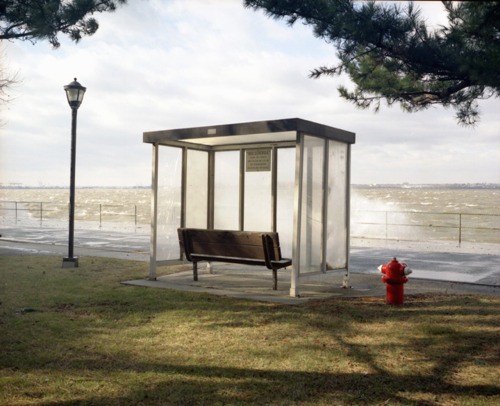
© Lisa Kereszi, Bus stop with sea spray, Governors Island, NY 2003
Photography books are receiving a lot of attention now, perhaps due to a new breed of photographer/book artist. Many photographers place themselves in one camp or another in terms of how they like their work to be read. What are your thoughts on the differences between photography in books, photography on the web, photography on the wall, etc.?
LK: Well, I suppose the web is the worst venue for detail and a sense of surface and what the piece should do in a room. It is the best for mass distribution and democratic exposure. Images in books don’t have that wall presence, but they are intimate and solid, and stay forever. They also follow a strict sequence that cannot be altered without an x-acto knife, so the artist’s intentions are very clear. I don’t feel like I am in one camp or another. What is great about photography is that it is reproducible, and that it can function at different sizes in different forms. The junkyard book is one I finally feel the most proud of. Fun and Games made sense to me as I sequenced it, but I am not sure everyone gets it. It can seem a little obscure.
Do you find a teaching career symbiotic with your career as an artist? How do you structure your artistic practice around your commitment to your program and students?
LK: Sometimes I feel a little conflicted about being part of the academic world and also a part of the art world—both can feel removed from the real world. Too many people in both don’t know what’s really going on outside, on the ground. This is a blanket statement, I know, with many exceptions. Many art historians don’t know the first thing about what it might mean to be a photographer, to engage in that practice, to engage with the world in person, not through a mediated research experience. And the art world is a business; at least academia is about educating people to move forward, or at least it should be. At Yale, I am very lucky to work with a lot of the undergraduates, and the redeeming value is that so many of them are going to go on to do good. So many will go on, in fact, to do great things, and I feel like I am doing something important by merely being a part of their lives for this brief moment, and showing them how to see, and how to interact with the environment and the people outside of the so-called ivory tower. I think it’s extremely important that they experience things firsthand, not just from a book or computer screen. I felt guilty for a while teaching mostly children of privilege, rather than bringing photography and art into a less fortunate community, something my sister is involved in. But I really do believe that if I can affect a future leader of America in some small way to care about his or her world in a deep and personal way, I can possibly effect change that I will never even know about. I actually feel more committed to that in some ways than to working with MFA students, who already know that they will be artists. Yes, artists make statements and can affect groups of people, and I wouldn’t do it if I didn’t believe that, but there is something to it to help shape a future leader of America. I know that Yale will one day have a better example of a presidential alum than that name that jumps to mind right now. I didn’t really answer your question, but felt that all of that was very important for me to say.
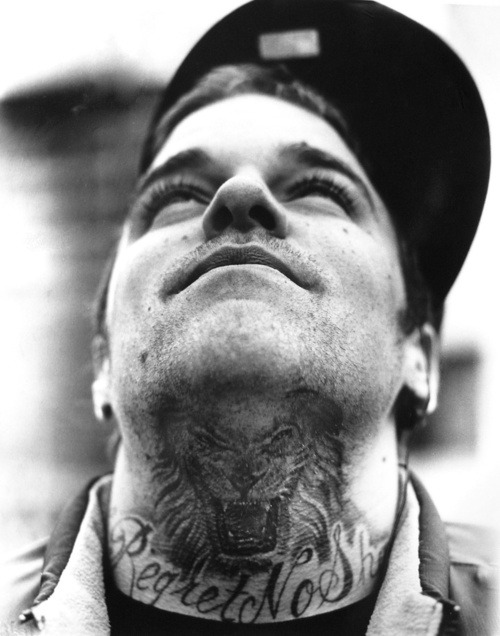
© Cooper Lewis, 2010 (Lisa Kereszi student's work)
A teaching career can be symbiotic, but it can also produce a distracted and willing-to-settle individual. I feel like sometimes the academic setting can cause someone to think too much about what it is that he or she does, and possibly even start to think the “wrong” things, depending on who your colleagues are. One reason I loved being back at Yale just four years after graduating is that I feel like I am getting paid to get my education over and over again. Not only do I have to teach myself how to explain things and critique work as I go, but I also am around the best of the best, who are sitting on critique panels and presenting visiting artist lectures. I just keep absorbing, albeit selectively. I am a lecturer officially, so I don’t get a sabbatical, and have been afraid to ask for a semester off (plus, since the recession started, that would be something I wouldn’t feel like I could financially afford to do). I do wish I had more uninterrupted time to just make work. But it’s my fault for not using the time that I do have productively. (I teach two days a week, but the other days can get “hijacked.”) I feel like I have had three jobs for a long time: teacher, artist, and editorial photographer, not to mention just living, being a human being, you know, running errands and doing chores. What students don’t realize is that when I go home, the workday is not over. In fact, it’s just beginning as far as my own artwork is concerned. This year, in particular, seems busier than it has been for a while. No, I am not traveling doing assignment work so much anymore, but I am now working with the MFA students on the weekly critique panel, plus putting together a very personal book, sowing the seeds for the next one, prepping for my next show at Yancey Richardson, as well as doing talks and guest-artist stints at places like Colby College and other venues. I forced myself yesterday to make three appointments to shoot things I had been thinking about for months. If I am going to call myself a photographer, I ought to go take some pictures!
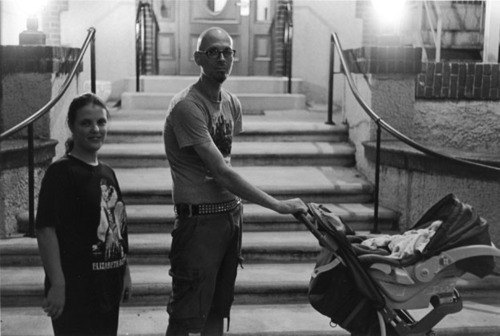
© Brendan Ternus, Dennis and Family, 2011 (Lisa Kereszi student's work)
---
LINKS
Lisa Kereszi
United States
share this page